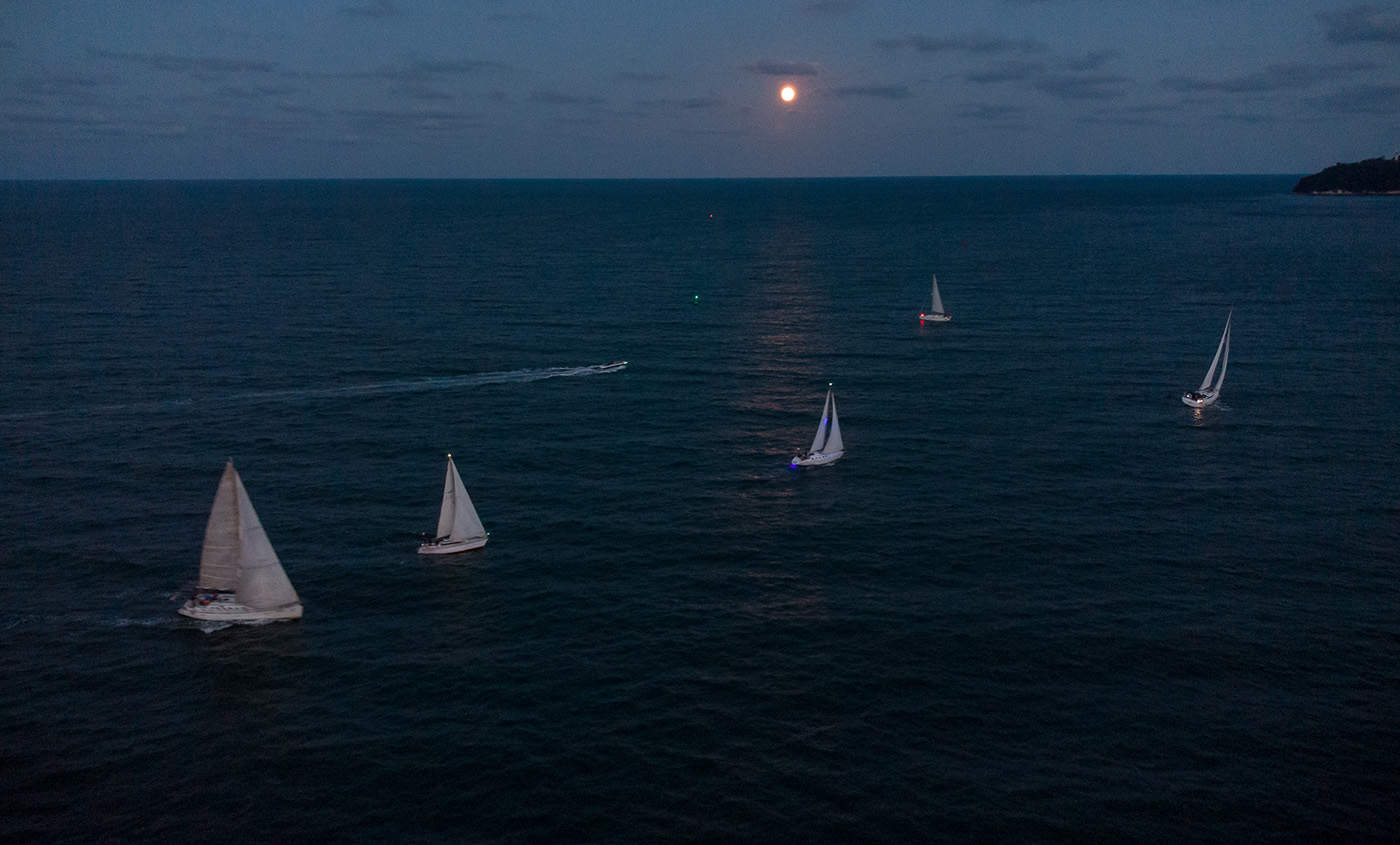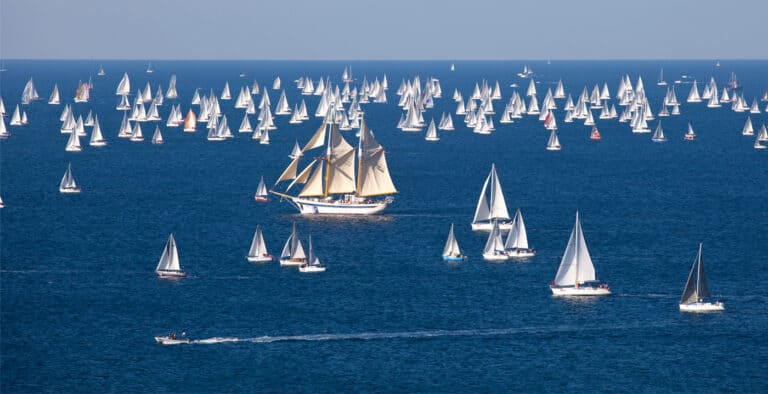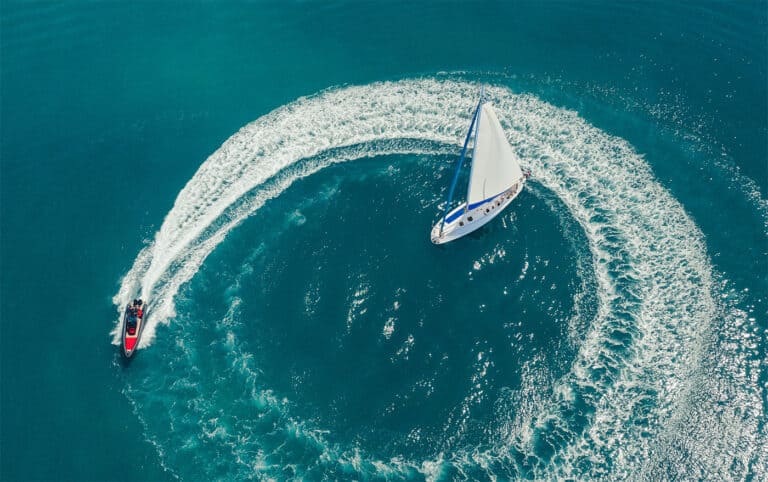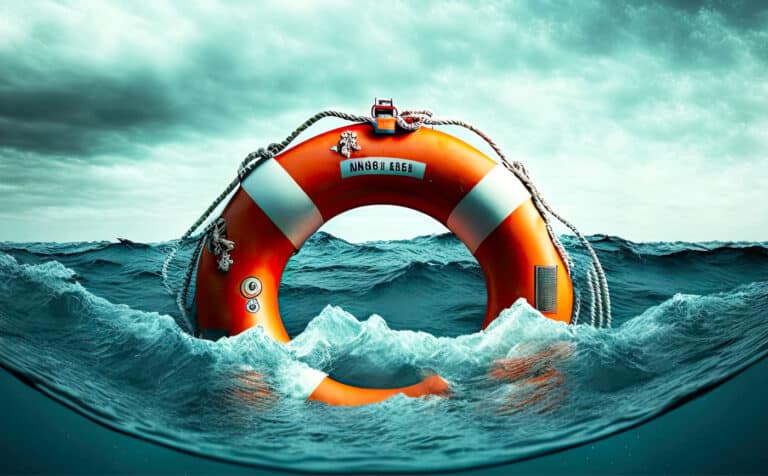Boats use lights to communicate messages to one another.
These are particularly important at night, or in poor weather conditions like fog or rain when visibility levels are low and it’s difficult to pick up on other boats within your proximity.
All power-driven boats must possess a forward masthead light, sidelights, and a stern light.
Most small boats like bowriders and runabouts will have a white light affixed to the top of a light pole that is connected to the stern of the craft.
This light then acts as an all-around light to function as a combined masthead and sternlight.
It’s essential that it is mounted higher than the boat structure and that it’s visible in all directions, and not obscured by the cockpit or any other part of the boat.
- When Boating At Night, What Does A Single White Light On A Boat Tell You?
- Basic Light Rules
- Navigation Lights and Vessel Size
- Powerboats and Sailboats Under Power
- Sailboats When Under Sail
- Vessels at Anchor
- Oar-Driven and Paddled Vessels, such as Rowboats, Kayaks and Canoes
- Minimum Visibility Range
- Final Verdict
When Boating At Night, What Does A Single White Light On A Boat Tell You?
So what does a single white light mean if a boat displays one at night?
A single white light can indicate several things, but the overall message is that you DO NOT have the right-of-way.
It can mean one of three things:
- You are approaching another boat from behind
A sole white light can be used to indicate that you may be approaching another craft from behind.
If this happens, it’s up to you to give way to the other craft and you must take early action to give the other boat a wide birth by altering your course and passing at a safe distance on the starboard (right) or port (left) side.
- You are approaching a non-powered craft
A white light can also be used to indicate that you’re approaching a non-powered craft, in which case you are the give-way craft and it’s up to you to yield the right of way.
Again, you need to alter your course and ensure you pass at a safe distance.
It’s also important to remember that if you’re operating a non-powered craft at night, you are required to have a white light in the form of an electric torch, flashlight, or lighted lantern – that’s if your boat cannot be equipped with standard navigation lights.
- You are approaching an anchored craft at night
Anchored crafts will also use a white light to indicate that you are approaching them.
Anchored boats should only display a white light – not their green or red sidelights – as these would indicate to other boaters (see gifts boaters love here) that the craft is underway.
Basic Light Rules
- Port sidelights are red are shine dead ahead to 112.5° aft.
- Starboard sidelights are green and also shine ahead to 112.5° aft.
- Stern lights are white and shine aft at 67.5° forward on each side. Together with the sidelights, these create a full circle of light.
- All-round lights are white and shine through 360°.
- Masthead lights are also white. These shine from 112.5° on the port side through dead ahead to 112.5° on the starboard side for a total of 225° forward. They are required to be positioned above the sidelights.
Navigation lights requirements vary depending on the size of the vessel.
For example, larger boats are required to use lights capable of a higher visibility range and are not permitted to combine sidelights into a single bi-color light.
Here are some of the basic rules and variations.
Powerboats and Sailboats Under Power
Powerboats and sailboats under power are required to have sidelights, a masthead light, and a stern light installed, though there are some variations to this rule.
- Powerboats under 12m in length (39.4′) can substitute a single all-round light for separate stern and masthead lights.
- Powerboats and sailboats under power that measure less than 20m (65.7′) can substitute a single bi-color light for sidelights.
Sailboats When Under Sail
Generally speaking, sidelights and a stern light are required, though there are some permissible variations:
- Sailboats under 20m (65.7′) can substitute a tricolor light for separate sidelights and stern light, or alternatively, a bi-color light and a stern light.
- Sailboats under 7m (23′) must exhibit lights as explained above if possible, though an electric torch or lighted lantern with a white light would be an acceptable substitute and should be used in sufficient time to prevent a collision.
Vessels at Anchor
Vessels anchored at night must display an all-around white light that is visible for at least 2nm.
During the day, a black anchor ball must be displayed by vessels anchored outside a designated anchorage.
Oar-Driven and Paddled Vessels, such as Rowboats, Kayaks and Canoes
Rowed or paddled vessels should adhere to the same light requirements as sailboats, though an acceptable substitute is an electric torch or lighted lantern indicating a white light.
Minimum Visibility Range
- Boats measuring less than 12m (39.4′) must have sidelights visible for at least 1nm, while all other lights must be visible for at least 2nm.
- Boats less than 20m (65.7′), must possess a masthead light that is visible for 3nm, and all other lights displayed by the vessel must be visible for 2nm.
- Boats over 20m (65.7′) and less than 50m (164′) must display a masthead light that is visible for 5nm, and all other lights must be visible for 2nm.
Final Verdict
Boats are required to show specific lights at night or in times of poor visibility.
Displaying the right color lights, in the right position, and ensuring that they are visible within the required range is essential to ensure optimal safety when boating at night.
Lights are pretty much the way in which boats and ships communicate in times of poor visibility, so ensuring you understand the basics of the nautical lighting rules is essential before you operate a boat at night, as sailing in the dark, or in low visibility, presents a special set of challenges and fulfilling the basic light rules is your first step to ensuring the safety of yourself and others.




